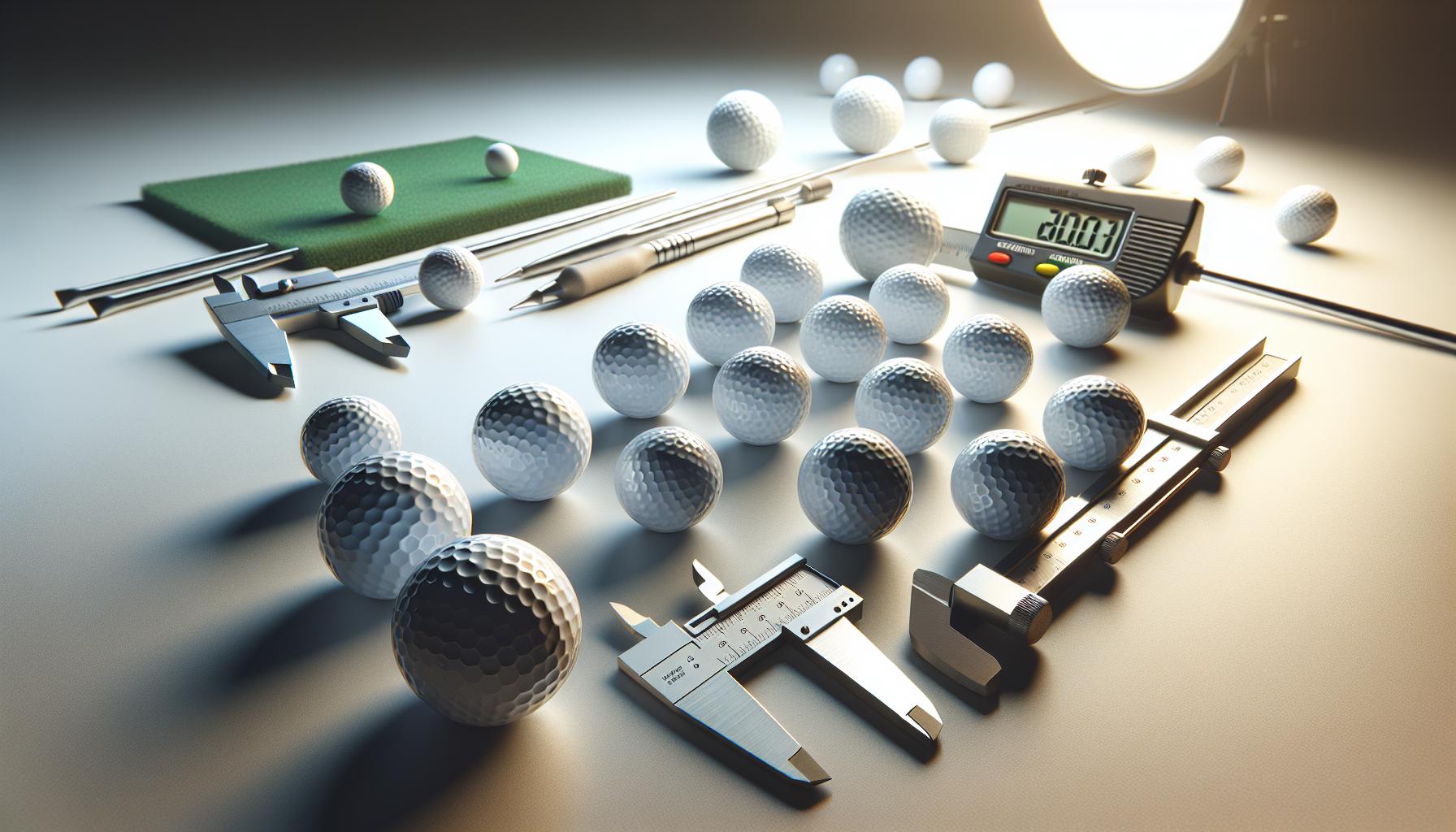When it comes to golf, even the smallest details can make a significant impact on your game. One crucial but often overlooked factor is the size of a golf ball. Officially, a golf ball must have a diameter of at least 1.68 inches, as determined by regulatory bodies. Understanding this specification not only highlights the precision involved in golf ball design but also underscores its importance in performance, distance, and accuracy.
For golfers of all skill levels, knowing the specifics regarding ball dimensions can aid in selecting the right equipment tailored to your unique playing style. Whether you’re striving for increased distance off the tee or improved control around the greens, every aspect counts. Join us as we delve into the official specifications of golf balls, explore their impact on play, and help you make informed decisions that can elevate your performance on the course.
How Golf Ball Size is Measured and Defined
To understand the size of a golf ball, it’s essential to first recognize that the dimensions are not arbitrary; they are strictly regulated. According to the United States Golf Association (USGA) and the R&A, which governs the sport worldwide, a standard golf ball must have a diameter of at least 1.68 inches (42.67 mm) and weigh no more than 1.62 ounces (45.93 grams). This size standard ensures consistency across the various types of golf balls played in both amateur and professional contexts, thereby maintaining fairness in competition.
Measuring a golf ball’s size involves using precise tools and methodologies. The most straightforward approach is to use a caliper or a measuring tape designed for small diameters. To obtain an accurate measurement, place the ball on a flat surface, ensuring that it is not resting on any uneven or soft area which could alter the results. Carefully measure the diameter at its widest point to ensure compliance with the stipulated specifications.
In practice, while all major manufacturers adhere closely to these regulations, slight variations may still be found. Some brands might prioritize certain features-such as aerodynamic performance and spin characteristics-leading to differences in surface texture or overall shape, which can affect playability without straying from the legal size. It’s also noteworthy that a golf ball’s construction can impact its perceived size; for example, a ball with a firmer core may feel different compared to one with a softer core, even if both are technically the same size.
Thus, while the regulations provide a solid framework, the nuances of golf ball design and materials can influence how various balls perform under different conditions, making the choice of a golf ball a vital consideration for players looking to optimize their game. A clear understanding of size specifications is fundamental when selecting equipment suitable for individual playing styles.
Official Dimensions of a Standard Golf Ball
A standard golf ball’s dimensions are not just a footnote in the sport’s regulations; they are critical to ensuring consistent performance and fairness during play. According to the United States Golf Association (USGA) and The R&A, the governing bodies for golf, a golf ball must have a minimum diameter of 1.68 inches (42.67 mm) and a maximum weight of 1.62 ounces (45.93 grams). These precise specifications create a uniform standard that helps players achieve comparable results when using different brands or models.
Understanding these official dimensions is essential for every golfer, whether you’re a seasoned pro or just starting. The minimum diameter requirement ensures that all golf balls will behave similarly in terms of aerodynamics and flight characteristics. Meanwhile, the weight limit is crafted to maintain playability and energy transfer from club to ball, which influences how far the ball travels and how it responds to impact. When selecting golf balls, using these official dimensions as a benchmark can significantly aid in performance optimization.
Why Dimensions Matter
The adherence to these specifications does more than maintain consistency; it also allows golfers to explore various styles and materials without worrying that a deviation in size will compromise their game. For example, a golf ball designed for maximum spin might look and feel different compared to one engineered for distance. While both adhere to the official size regulations, their performance characteristics may vary significantly, affecting playability and choice.
Choosing the right golf ball with the correct dimensions aligns with a player’s skill level and playing style. Beginners may benefit more from a ball that maximizes distance and forgiveness, while skilled players might prefer those engineered for spin control and precision. Understanding how a ball fits within the predefined specifications can guide you in selecting the gear that complements your game best. Always remember that while multiple options might seem attractive, compliance with standard dimensions is the baseline to ensuring fair competition and enhancing your golf experience.
Variations in Golf Ball Sizes Across Brands
While all golf balls must adhere to specific minimum and maximum dimensions as defined by the USGA and The R&A, not every brand delivers exactly the same size when it comes to their products. Variations in golf ball sizes, while usually negligible, can still have an impact on performance and feel, depending on the brand and model used. Therefore, understanding these differences can aid golfers in selecting the right ball suited to their game.
Many manufacturers design golf balls that may sit at the higher or lower ends of the standard size spectrum. For instance, while a ball must measure at least 1.68 inches in diameter, some brands like Titleist and Callaway might produce balls that are very close to this minimum, promoting specific performance characteristics. On the other hand, brands such as Srixon and Bridgestone might create balls that just slightly exceed the minimum diameter, claiming that even the slightest increase can boost aerodynamics and stability during flight.
Furthermore, differences can also stem from the construction and overall design philosophy of each brand. Companies often blend materials and technologies that cater to different playing styles. For example, a ball designed for high spin and control might differ slightly in dimensions from one built for maximum distance, as manufacturers may prioritize certain performance variables over strict size uniformity. These variations can subtly influence how the ball interacts with the clubface and how it behaves in flight.
When selecting a golf ball, it’s important for players to test several brands and models to determine which size and type feels most comfortable and performs best for their specific swing. Product reviews and personalized fitting sessions can also help in making these critical decisions. Comprehending the influence of brand variations not only enhances gameplay but also fosters informed choices, ensuring players find the ideal balance between performance and preference.
Understanding Compression Ratings and Their Impact
Understanding compression ratings is crucial for golfers aiming to optimize their performance on the course. Compression refers to the hardness or softness of a golf ball, quantified on a numeric scale. Most golf balls are rated between 30 to 110, where a lower compression rating indicates a softer ball, typically designed to enhance distance for players with slower swing speeds, while higher compression balls are stiffer and provide greater control for faster swing speeds.
When golfers strike a ball during play, the compression rating plays a significant role in how the ball behaves. A lower compression ball compresses more upon impact, allowing for a larger deformation, which can result in a higher launch angle and more distance, particularly beneficial for beginners and those with slower swings. Conversely, high-compression balls tend to offer reduced spin, promoting straighter shots for experienced players who can generate adequate clubhead speed.
It’s also essential to consider the relationship between compression and feel. Players often associate softer balls with a better feel around the greens, which can improve short game performance. For instance, a popular model like the Callaway Supersoft has a lower compression rating, making it appealing for players seeking maximum distance without sacrificing feel. On the other hand, balls like the Titleist Pro V1, with a higher rating, cater to skilled players wanting optimal control and feedback on their shots.
Ultimately, choosing the right compression is a personalized decision that requires consideration of individual swing speed, overall feel preference, and playing style. To find the ideal match, golfers should test various balls under real playing conditions, paying close attention to how each option performs in terms of distance and touch around the greens. By , players not only enhance their game but also foster more enjoyment on the course.
How Golf Ball Construction Affects Performance
Understanding how golf ball construction impacts performance can significantly enhance your game. Golf balls are typically composed of several layers, with each layer serving a distinct purpose that influences distance, feel, and spin characteristics. Most modern golf balls are manufactured with either a two-piece or multi-layer (three-piece or four-piece) construction, and these design choices directly affect their performance profiles.
The two-piece golf ball consists of a solid core and a durable outer cover. This design maximizes distance by reducing spin and promoting a straight flight path, making it an ideal choice for beginners or higher-handicap players. On the other hand, multi-layer balls feature a more complex structure, often with a softer cover that facilitates greater spin on approach shots and better control around the greens. For instance, the Titleist Pro V1, a favorite among low-handicap players, combines a soft urethane cover with a solid core, optimizing both distance and feel.
Core Material and Design
The core of a golf ball plays a pivotal role in determining its performance. Generally, softer cores will provide better feel and more spin, while firmer cores tend to yield longer distances. For instance, balls like the Callaway Chrome Soft feature a proprietary Graphene-infused core design aimed at balancing soft feel with resilience, enhancing both distance and control.
Cover Material
The cover material also significantly contributes to performance characteristics. Urethane covers, found on premium models, provide increased spin and feel, particularly beneficial for short game shots. In contrast, ionomer covers, typically seen on lower-priced balls, provide durability and are less prone to scratches but may sacrifice some feel and spin. Understanding these distinctions allows players to select a ball that aligns with their playing style and preferences.
Choosing the right golf ball involves evaluating how the construction characteristics-core type, cover material, and layer count-align with your specific needs on the course. While a ball designed for maximum distance may work well on the driving range, it’s essential to consider how it feels and performs during your short game. Testing different balls during actual play can help you assess their performance under various conditions, leading to more informed and personal buying decisions that align with your unique skill set.
The Role of Ball Materials in Size Specifications
Understanding the role of materials in golf ball construction is essential for appreciating how size specifications are determined and validated. Each material significantly influences not just the performance characteristics, but also the overall dimensions and regulation compliance of the golf ball. Officially, a golf ball must have a diameter of at least 1.68 inches, according to the USGA and R&A. However, this size is often affected by the materials used in the ball’s construction.
The core of the golf ball predominantly dictates its size. Many manufacturers utilize polybutadiene rubber to create a soft core, which can expand slightly during production to ensure the final size remains compliant. The outer cover, typically made from materials like urethane or ionomer, also has an impact on the overall size due to its thickness and flexibility. Urethane covers, while offering a softer feel and improved spin, can add marginally to the ball’s diameter due to their unique properties when molded. Conversely, ionomer covers are denser and can keep the ball within size regulations, though they sacrifice some feel and spin performance.
Material Influence on Weight and Size
In addition to diameter, the materials used in golf balls also influence weight and, consequently, how the ball performs in terms of aerodynamics and distance. For instance, most regulation golf balls must weigh between 1.62 ounces and 1.68 ounces. The choice of materials can affect the final weight-solid cores made of synthetic materials can often reach the upper limits of this specification without compromising durability.
When selecting a golf ball, consider how materials affect not just feel and spin, but also the adherence to size regulations. A ball designed with compliance in mind may perform differently than one that pushes the boundaries of size specifications while optimizing distance and control. Players looking for maximum performance should test various brands, as even slight variances in size due to construction material can impact how a ball plays under different conditions.
In summary, the interplay between materials and size specification is crucial for players aiming to optimize their game. By understanding how different materials influence both the dimensions and performance characteristics of golf balls, golfers can make better-informed decisions regarding their equipment. Based on the core and cover choices, players can select a ball that aligns with their preferred playing style, thus enhancing their performance on the course.
Choosing the Right Golf Ball for Your Game
Selecting the right golf ball is pivotal for optimizing your game, as it can significantly influence your performance based on your playing style, swing speed, and personal preferences. With a standard golf ball measuring at least 1.68 inches in diameter, understanding the nuances of golf ball technology goes beyond just size. Golf balls come in various constructions and types, each designed to cater to specific player needs.
When choosing a golf ball, consider factors like compression ratings, which measure how much the ball compresses upon impact. A lower compression ball (around 70-80) is typically better suited for players with slower swing speeds, promoting higher launch and greater distance. Conversely, a higher compression ball (90+) offers optimal performance for stronger players, providing greater control and spin around the greens. Some popular options include:
- Titleist Pro V1: Known for its exceptional feel and control, suitable for players seeking spin and consistency.
- Callaway Chrome Soft: A lower compression option ideal for players wanting a soft feel and increased distance.
- Bridgestone Tour B RX: Engineered for faster swing speeds, offering a mix of distance and spin control.
Ball construction also plays a crucial role in performance. Golf balls are primarily designed with two or three layers, affecting their feel and trajectory. A two-piece ball is generally more durable and provides distance, making it suitable for beginners, while three-piece or multi-layer balls enhance spin and control, ideal for advanced players.
Real-world testing can be crucial in making your decision. Utilize a launch monitor if available, or participate in golf ball fitting sessions at your local pro shop. Pay attention to how the ball performs in terms of distance, feel, and bounce during practice or play. Ultimately, by aligning your choice with your unique swing characteristics and performance objectives, you can find the golf ball that not only meets regulatory standards but also maximizes your potential on the course.
Common Myths About Golf Ball Size Debunked
Many golfers are under the impression that smaller golf balls can provide increased control and accuracy, while larger ones enhance distance. However, this assumption overlooks the strict regulations set by governing bodies like the USGA and R&A. The official diameter of a golf ball must not be smaller than 1.68 inches, making this the minimum size allowable for competitive play. Contrary to popular belief, the difference in diameter can cause more significant variations in performance than one might expect.
Another myth surrounds the idea that all golf balls from different brands are created equal in terms of size. In reality, while they all must comply with the minimum diameter, brands may slightly vary in their dimensions due to manufacturing tolerances. Even slight differences can influence aerodynamics and how the ball interacts with clubs, especially at high speeds. For instance, a ball that strays too close to the upper limit of the regulation diameter might behave differently in flight compared to a ball just meeting the minimum standard.
Some players also believe that the size of the golf ball affects its compression. In truth, compression is more about the materials and construction used rather than its size. Two balls of identical size could have vastly different compression ratings due to differences in their internal structure. Low-compression golf balls are often favored by slower swing speed players for better distance, while high-compression balls are preferred by those with higher swing speeds for enhanced control and spin.
Finally, a persistent myth is centered around the idea that golf ball size can be adjusted for better performance, such as shrinking or enlarging through heat or pressure. This misconception can lead to compromised ball integrity and performance. Instead of attempting to modify a ball’s size, golfers should focus on selecting a ball that aligns with their playing style and swing characteristics for optimal performance. Recognizing these myths can help golfers make better choices, enhancing their overall experience on the course.
How to Measure a Golf Ball at Home
Measuring a golf ball at home can be a straightforward process that helps you ensure you’re playing with equipment that meets the official specifications. The standard diameter for a competitive golf ball is 1.68 inches (or 42.67 mm) and should not exceed 1.75 inches (or 44.45 mm). By measuring your golf balls accurately, you can determine if they conform to regulations and might even discover subtle variations between brands.
To measure a golf ball effectively, follow these steps:
- Gather Your Tools: You will need a precision measuring tool such as calipers or a ruler that can measure in both inches and millimeters.
- Position the Ball: Place the golf ball on a flat, stable surface to ensure accurate measurements. A non-marble, clean table works best, as it reduces the chance of movement.
- Measure the Diameter: If using calipers, gently clamp them around the ball’s equator and note the measurement. If using a ruler, ensure it’s properly aligned at the widest part of the ball for an accurate diameter reading. With a ruler, you may need to convert measurements from fractions to decimals for precision.
Make sure to measure at multiple angles if you’re using a ruler to confirm consistency. Many golfers may not realize that slight differences in size can affect performance. A ball measuring slightly larger may behave differently in flight due to aerodynamics.
For those who might be considering the effects of wear or deformation on a golf ball’s size, keep in mind that as golf balls age, their outer cover can become more compressed, potentially affecting their dimensions. Regularly checking your golf balls not only helps determine compliance with size regulations but also allows you to understand how different brands and types may interact with your swing mechanics.
Impact of Weather on Golf Ball Performance
When it comes to golf balls, weather conditions play a crucial role in determining how well a ball performs on the course. Temperature, humidity, and wind not only affect the distance the ball travels but can also influence its feel and control. For example, warmer temperatures generally lead to increased air density, resulting in a longer flight and reduced spin, while cooler conditions can shorten distances due to decreased ball elasticity and heightened air resistance.
One of the most significant weather impacts is humidity. High humidity can make the air denser, which might inhibit the golf ball’s flight. Conversely, lower humidity typically allows the ball to slice through the air more efficiently, potentially adding extra yards to your drive. Wind is another critical factor; it can alter the trajectory of shots, lift or drag the ball, and even change how players read putts on the green. A strong crosswind can push a ball off its intended line, making it essential for golfers to adjust their aim and club selection accordingly.
To optimize performance based on weather conditions, players should consider adjusting their equipment. For instance, using balls with lower compression ratings can provide better feel and control in colder weather, compensating for the reduced distance caused by increased air density. In contrast, during hot and humid days, golfers might benefit from using a firmer ball that enhances distance and minimizes unease often felt from softer options.
Lastly, being aware of these weather-related impacts enables players to make strategic adjustments throughout their rounds. When facing challenging conditions, such as a gusty wind or sudden temperature shifts, recognizing how these elements affect ball flight can significantly improve a golfer’s performance and lower their score. Preparing for these variables not only involves understanding how they alter ball behavior but also requires adapting one’s play style to meet the challenges presented by nature.
Golf Ball Size Regulations in Professional Tournaments
In the world of professional golf, adherence to specific regulations regarding equipment is paramount, especially when it comes to golf ball size. The United States Golf Association (USGA) sets stringent standards that dictate the official dimensions and performance characteristics of golf balls used in sanctioned tournaments. A standard golf ball must have a diameter of no less than 1.680 inches, or 42.67 millimeters, while the weight cannot exceed 1.620 ounces, or 45.93 grams. These specifications ensure a level playing field where players can rely on consistent ball performance, contributing to fair competition.
The rationale behind these regulations stems from the need to maintain both safety and integrity in the sport. If golf balls were allowed to vary significantly in size or weight, it could lead to unpredictable performance variations, giving manufacturers an unfair advantage based on technology. As such, the USGA’s oversight ensures that the equipment used is standardized, allowing skill and strategy to be the primary determinants of success on the course.
Moreover, adherence to these regulations is not just about size, but also involves the overall construction and materials used in golf ball manufacturing. Professional golfers often test various balls that meet the size requirements to find those that best suit their playstyle, factoring in attributes like compression and spin. For instance, a player might choose a softer ball for enhanced control around the greens, while another may prefer a firmer ball for its extra distance off the tee, all within the same regulatory confines. The diversity of options underscores the importance of understanding not just the size, but also the specific characteristics that can influence on-course performance.
As players prepare for competitive play, they must ensure their equipment complies with these regulations, which can typically be verified through USGA-approved lists. Familiarity with these guidelines allows golfers to optimize their ball selection effectively, enhancing their chances of performance consistency in high-stakes environments.
Tips for Golf Ball Storage and Care
To maximize the performance and longevity of your golf balls, understanding the optimal storage and care methods is essential. Golf balls are engineered with meticulous precision, where even minor damage can affect performance. Proper care can help maintain their playability, ensuring that they deliver consistent results on the course.
First and foremost, store your golf balls in a cool, dry place, away from direct sunlight and extreme temperatures. High temperatures can cause the materials in the golf ball-such as the core and cover-to degrade over time, resulting in loss of distance and accuracy. For instance, keep your balls in a temperature-controlled environment rather than a hot garage or car trunk. Use a protective container or ball bag that prevents them from being squished or damaged in transit.
When it comes to cleaning, avoid using harsh chemicals or abrasive materials that can scratch the surface. Instead, use a damp cloth or a soft, soapy solution to gently wipe them down after use to remove dirt and grime. Regular cleaning not only enhances the aesthetics of your balls but also can improve their aerodynamics by reducing surface debris that could impact performance during flight.
Additionally, pay attention to the lifespan of your golf balls. Although many premium balls can last a long time, the performance of balls designed for distance may diminish after several rounds, particularly if they’ve encountered trees, cart paths, or water hazards. It’s wise to rotate your golf balls, using new or slightly used ones for crucial rounds while keeping older or damaged ones for practice sessions.
By following these practical storage and care tips, you can preserve the integrity and performance of your golf balls, ensuring that they remain reliable partners in your quest for golfing excellence.
FAQ
Q: What are the standard dimensions of a golf ball?
A: A standard golf ball must have a diameter of 1.68 inches (42.67 mm) and a weight not exceeding 1.62 ounces (45.93 grams) according to the Rules of Golf. This specification helps maintain consistency across the sport and affects performance aspects like distance and control.
Q: How can I measure a golf ball at home?
A: To measure a golf ball at home, use a precise caliper or measuring tape. Simply measure the diameter across the ball’s widest point; it should be approximately 1.68 inches if it’s standard size. This simple check can confirm compliance with regulations.
Q: Do different types of golf balls have different sizes?
A: While most golf balls comply with the standard size of 1.68 inches in diameter, some specialty balls may have slight variations in size. However, all conforming balls used in official play must adhere to the 1.68-inch diameter rule.
Q: What factors influence golf ball size regulations in professional play?
A: Golf ball size regulations are influenced by performance standards, aimed at ensuring fair competition. The diameter of 1.68 inches optimizes aerodynamics and performance metrics like distance and accuracy, which are crucial in professional settings.
Q: Why does golf ball size matter for performance?
A: Golf ball size directly impacts performance, including aerodynamics, spin, and distance. Balls that meet the 1.68-inch specification maintain a balance between control and travel distance, crucial for players aiming to optimize their game.
Q: Are all golf balls made to the same size?
A: Yes, all conforming golf balls are made to the same standard size of 1.68 inches in diameter. This uniformity is essential for consistency in performance during play, regardless of the brand or construction type.
Q: What is the difference between golf ball compression ratings?
A: Golf ball compression ratings reflect the ball’s hardness or softness and influence how it performs on impact. While this does not affect size, it affects feel and control. Higher compression balls suit faster swing speeds, while lower compression balls are ideal for slower swings.
Q: How can golf ball construction affect its size and performance?
A: Though the size of golf balls adheres to the standard specification, the internal construction can vary. Multi-layer designs or different core materials can influence how the ball compresses upon impact, which in turn affects how it travels through the air and its overall performance characteristics.
Closing Remarks
Understanding the official size of a golf ball is just the beginning of optimizing your game. With a diameter of 1.68 inches, these small spheres can significantly impact your performance. Now that you’re equipped with this knowledge, consider how choosing the right golf ball can enhance your distance and control on the course. Dive deeper into our articles on comparing different golf ball brands and the science behind compression ratings to further refine your selection process.
Don’t miss out on our exclusive resources for finding the perfect ball fit for your swing style. Sign up for our newsletter to stay updated on the latest trends and tips in golf ball technology, ensuring you’re always ahead in your game. Share your thoughts below or explore related topics to keep the conversation going. Your optimized golf experience starts here-make every swing count!

